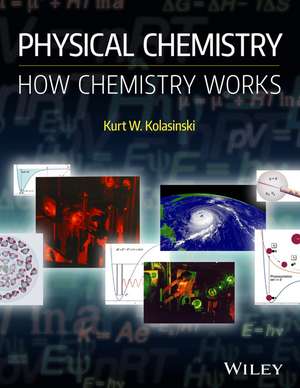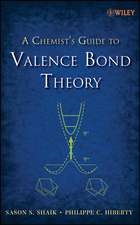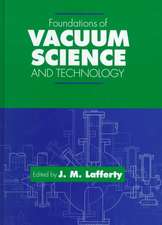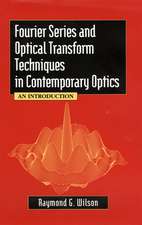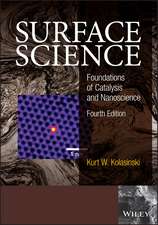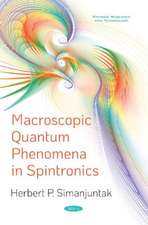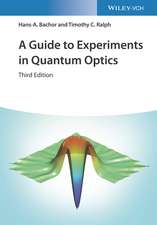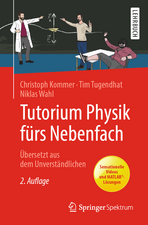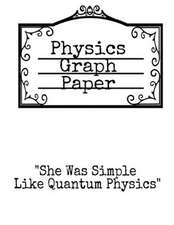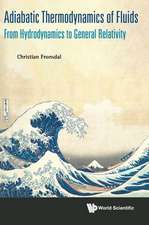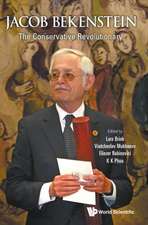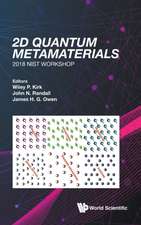Physical Chemistry – How Chemistry Works
Autor KW Kolasinskien Limba Engleză Paperback – 10 noi 2016
Preț: 643.30 lei
Preț vechi: 835.46 lei
-23% Nou
Puncte Express: 965
Preț estimativ în valută:
123.11€ • 133.68$ • 103.41£
123.11€ • 133.68$ • 103.41£
Carte tipărită la comandă
Livrare economică 22 aprilie-06 mai
Preluare comenzi: 021 569.72.76
Specificații
ISBN-13: 9781118751121
ISBN-10: 1118751124
Pagini: 744
Dimensiuni: 219 x 277 x 35 mm
Greutate: 1.84 kg
Editura: Wiley
Locul publicării:Chichester, United Kingdom
ISBN-10: 1118751124
Pagini: 744
Dimensiuni: 219 x 277 x 35 mm
Greutate: 1.84 kg
Editura: Wiley
Locul publicării:Chichester, United Kingdom
Public țintă
An undergraduate text for use in the third or fourth years of an American undergraduate career, or throughout the undergraduate UK program.Also of relevance for postgraduate students on more advanced courses in physical chemistry.
Undergraduates in materials science, chemical engineering and biology looking for an accessible and practical introduction to physical chemistry.
Cuprins
Preface xv About the companion website xvii 1 Introduction 1 1.1 Atoms and molecules 1 1.2 Phases 2 1.3 Energy 3 1.4 Chemical reactions 4 1.5 Problem solving 5 1.6 Some conventions 7 Exercises 11 Further reading 14 2 Ideal gases 15 2.1 Ideal gas equation of state 16 2.2 Molecular degrees of freedom 18 2.3 Translational energy: Distribution and relation to pressure 21 2.4 Maxwell distribution of molecular speeds 23 2.5 Principle of equipartition of energy 24 2.6 Temperature and the zeroth law of thermodynamics 25 2.7 Mixtures of gases 27 2.8 Molecular collisions 27 Exercises 29 Further reading 30 3 Non-ideal gases and intermolecular interactions 31 3.1 Non-ideal behavior 31 3.2 Interactions of matter with matter 32 3.3 Intermolecular interactions 34 3.4 Real gases 39 3.5 Corresponding states 42 3.6 Supercritical fluids 43 Exercises 43 Further reading 44 4 Liquids, liquid crystals, and ionic liquids 45 4.1 Liquid formation 45 4.2 Properties of liquids 45 4.3 Intermolecular interaction in liquids 47 4.4 Structure of liquids 50 4.5 Internal energy and equation of state of a rigid sphere liquid 52 4.6 Concentration units 53 4.7 Diffusion 55 4.8 Viscosity 57 4.9 Migration 59 4.10 Interface formation 60 4.11 Liquid crystals 62 4.12 Ionic liquids 64 Exercises 66 Further reading 67 5 Solids, nanoparticles, and interfaces 68 5.1 Solid formation 68 5.2 Electronic structure of solids 70 5.3 Geometrical structure of solids 72 5.4 Interface formation 76 5.5 Glass formation 78 5.6 Clusters and nanoparticles 78 5.7 The carbon family: Diamond, graphite, graphene, fullerenes, and carbon nanotubes 80 5.8 Porous solids 83 5.9 Polymers and macromolecules 84 Exercises 86 Endnotes 86 Further reading 86 6 Statistical mechanics 87 6.1 The initial state of the universe 88 6.2 Microstates and macrostates of molecules 89 6.3 The connection of entropy to microstates 91 6.4 The constant alpha: Introducing the partition function 93 6.5 Using the partition function to derive thermodynamic functions 94 6.6 Distribution functions for gases 96 6.7 Quantum statistics for particle distributions 98 6.8 The Maxwell-Boltzmann speed distribution 102 6.9 Derivation of the ideal gas law 103 6.10 Deriving the Sackur-Tetrode equation for entropy of a monatomic gas 104 6.11 The partition function of a diatomic molecule 106 6.12 Contributions of each degree of freedom to thermodynamic functions 106 6.13 The total partition function and thermodynamic functions 111 6.14 Polyatomic molecules 113 Exercises 115 Endnotes 116 Further reading 116 7 First law of thermodynamics 117 7.1 Some definitions and fundamental concepts in thermodynamics 118 7.2 Laws of thermodynamics 118 7.3 Internal energy and the first law 119 7.4 Work 121 7.5 Intensive and extensive variables 123 7.6 Heat 124 7.7 Non-ideal behavior changes the work 125 7.8 Heat capacity 126 7.9 Temperature dependence of Cp 127 7.10 Internal energy change at constant volume 129 7.11 Enthalpy 130 7.12 Relationship between CV and Cp and partial differentials 131 7.13 Reversible adiabatic expansion/compression 133 Exercises 136 Endnotes 138 Further reading 138 8 Second law of thermodynamics 139 8.1 The second law of thermodynamics 140 8.2 Thermodynamics of a hurricane 141 8.3 Heat engines, refrigeration, and heat pumps 145 8.4 Definition of entropy 148 8.5 Calculating changes in entropy 150 8.6 Maxwell's relations 152 8.7 Calculating the natural direction of change 154 Exercises 157 Endnotes 159 Further reading 159 9 Third law of thermodynamics and temperature dependence of heat capacity, enthalpy and entropy 160 9.1 When and why does a system change? 160 9.2 Natural variables of internal energy 161 9.3 Helmholtz and Gibbs energies 162 9.4 Standard molar Gibbs energies 163 9.5 Properties of the Gibbs energy 164 9.6 The temperature dependence of DeltarCp and H 168 9.7 Third law of thermodynamics 170 9.8 The unattainability of absolute zero 171 9.9 Absolute entropies 172 9.10 Entropy changes in chemical reactions 173 9.11 Calculating DeltarS* at any temperature 175 Exercises 177 Further reading 180 10 Thermochemistry: The role of heat in chemical and physical changes 181 10.1 Stoichiometry and extent of reaction 181 10.2 Standard enthalpy change 182 10.3 Calorimetry 184 10.4 Phase transitions 187 10.5 Bond dissociation and atomization 190 10.6 Solution 191 10.7 Enthalpy of formation 192 10.8 Hess's law 192 10.9 Reaction enthalpy from enthalpies of formation 193 10.10 Calculating enthalpy of reaction from enthalpies of combustion 194 10.11 The magnitude of reaction enthalpy 195 Exercises 196 Further reading 200 11 Chemical equilibrium 201 11.1 Chemical potential and Gibbs energy of a reaction mixture 201 11.2 The Gibbs energy and equilibrium composition 202 11.3 The response of equilibria to change 204 11.4 Equilibrium constants and associated calculations 209 11.5 Acid-base equilibria 212 11.6 Dissolution and precipitation of salts 216 11.7 Formation constants of complexes 219 11.8 Thermodynamics of self-assembly 222 Exercises 224 Endnote 228 Further reading 228 12 Phase stability and phase transitions 229 12.1 Phase diagrams and the relative stability of solids, liquids, and gases 229 12.2 What determines relative phase stability? 232 12.3 The p-T phase diagram 234 12.4 The Gibbs phase rule 237 12.5 Theoretical basis for the p-T phase diagram 238 12.6 Clausius-Clapeyron equation 240 12.7 Surface tension 242 12.8 Nucleation 246 12.9 Construction of a liquid-vapor phase diagram at constant pressure 250 12.10 Polymers: Phase separation and the glass transition 252 Exercises 254 Endnotes 255 Further reading 256 13 Solutions and mixtures: Nonelectrolytes 257 13.1 Ideal solution and the standard state 258 13.2 Partial molar volume 258 13.3 Partial molar Gibbs energy = chemical potential 259 13.4 The chemical potential of a mixture and DeltamixG 261 13.5 Activity 263 13.6 Measurement of activity 264 13.7 Classes of solutions and their properties 269 13.8 Colligative properties 273 13.9 Solubility of polymers 277 13.10 Supercritical CO2 279 Exercises 281 Endnote 282 Further reading 282 14 Solutions of electrolytes 283 14.1 Why salts dissolve 283 14.2 Ions in solution 284 14.3 The thermodynamic properties of ions in solution 287 14.4 The activity of ions in solution 289 14.5 Debye-Hückel theory 290 14.6 Use of activities in equilibrium calculations 292 14.7 Charge transport 295 Exercises 298 Further reading 299 15 Electrochemistry: The chemistry of free charge exchange 300 15.1 Introduction to electrochemistry 301 15.2 The electrochemical potential 306 15.3 Electrochemical cells 310 15.4 Potential difference of an electrochemical cell 312 15.5 Surface charge and potential 318 15.6 Relating work functions to the electrochemical series 319 15.7 Applications of standard potentials 321 15.8 Biological oxidation and proton-coupled electron transfer 326 Exercises 329 Endnotes 331 Further reading 332 16 Empirical chemical kinetics 333 16.1 What is chemical kinetics? 333 16.2 Rates of reaction and rate equations 335 16.3 Elementary versus composite reactions 336 16.4 Kinetics and thermodynamics 337 16.5 Kinetics of specific orders 338 16.6 Reaction rate determination 345 16.7 Methods of determining reaction order 346 16.8 Reversible reactions and the connection of rate constants to equilibrium constants 348 16.9 Temperature dependence of rates and the rate constant 350 16.10 Microscopic reversibility and detailed balance 353 16.11 Rate-determining step (RDS) 354 Exercises 355 Endnotes 359 Further reading 359 17 Reaction dynamics I: Mechanisms and rates 360 17.1 Linking empirical kinetics to reaction dynamics 360 17.2 Hard-sphere collision theory 361 17.3 Activation energy and the transition state 364 17.4 Transition-state theory (TST) 366 17.5 Composite reactions and mechanisms 368 17.6 The rate of unimolecular reactions 372 17.7 Desorption kinetics 374 17.8 Langmuir (direct) adsorption 378 17.9 Precursor-mediated adsorption 380 17.10 Adsorption isotherms 381 17.11 Surmounting activation barriers 382 Exercises 386 Endnotes 389 Further reading 390 18 Reaction dynamics II: Catalysis, photochemistry and charge transfer 391 18.1 Catalysis 392 18.2 Heterogeneous catalysis 393 18.3 Acid-base catalysis 402 18.4 Enzyme catalysis 403 18.5 Chain reactions 407 18.6 Explosions 410 18.7 Photochemical reactions 411 18.8 Charge transfer and electrochemical dynamics 415 Exercises 428 Endnotes 431 Further reading 431 19 Developing quantum mechanical intuition 433 19.1 Classical electromagnetic waves 434 19.2 Classical mechanics to quantum mechanics 443 19.3 Necessity for an understanding of quantum mechanics 444 19.4 Quantum nature of light 448 19.5 Wave-particle duality 449 19.6 The Bohr atom 453 Exercises 458 Endnotes 460 Further reading 461 20 The quantum mechanical description of nature 462 20.1 What determines if a quantum description is necessary? 463 20.2 The postulates of quantum mechanics 463 20.3 Wavefunctions 464 20.4 The Schrödinger equation 467 20.5 Operators and eigenvalues 469 20.6 Solving the Schrödinger equation 471 20.7 Expectation values 475 20.8 Orthonormality and superposition 477 20.9 Dirac notation 480 20.10 Developing quantum intuition 481 Exercises 486 Endnotes 488 Further reading 488 21 Model quantum systems 489 21.1 Particle in a box 490 21.2 Quantum tunneling 495 21.3 Vibrational motion 497 21.4 Angular momentum 500 Exercises 511 Endnotes 513 Further reading 513 22 Atomic structure 514 22.1 The hydrogenl atom 515 22.2 How do you make it better? the Dirac equation 518 22.3 Atomic orbitals 520 22.4 Many-electron atoms 524 22.5 Ground and excited states of He 528 22.6 Slater-Condon theory for approximating atomic energy levels 530 22.7 Electron configurations 533 Exercises 536 Endnotes 538 Further reading 538 23 Introduction to spectroscopy and atomic spectroscopy 539 23.1 Fundamentals of spectroscopy 540 23.2 Time-dependent perturbation theory and spectral transitions 544 23.3 The Beer-Lambert law 547 23.4 Electronic spectra of atoms 550 23.5 Spin-orbit coupling 551 23.6 Russell-Saunders (LS) coupling 554 23.7 jj-coupling 559 23.8 Selection rules for atomic spectroscopy 560 23.9 Photoelectron spectroscopy 561 Exercises 566 Endnotes 569 Further reading 569 24 Molecular bonding and structure 570 24.1 Born-Oppenheimer approximation 571 24.2 Valence bond theory 573 24.3 Molecular orbital theory 576 24.4 The hydrogen molecular ion H+2 577 24.5 Solving the H2 Schrödinger equation 580 24.6 Homonuclear diatomic molecules 585 24.7 Heteronuclear diatomic molecules 588 24.8 The variational principle in molecular orbital calculations 591 24.9 Polyatomic molecules: The Hückel approximation 593 24.10 Density functional theory (DFT) 597 Exercises 598 Endnotes 601 Further reading 601 25 Molecular spectroscopy and excited-state dynamics: Diatomics 602 25.1 Introduction to molecular spectroscopy 603 25.2 Pure rotational spectra of molecules 604 25.3 Rovibrational spectra of molecules 609 25.4 Raman spectroscopy 614 25.5 Electronic spectra of molecules 617 25.6 Excited-state population dynamics 622 25.7 Electron collisions with molecules 628 Exercises 629 Endnotes 632 Further reading 633 26 Polyatomic molecules and group theory 634 26.1 Absorption and emission by polyatomics 635 26.2 Electronic and vibronic selection rules 637 26.3 Molecular symmetry 641 26.4 Point groups 645 26.5 Character tables 647 26.6 Dipole moments 650 26.7 Rovibrational spectroscopy of polyatomic molecules 652 26.8 Excited-state dynamics 656 Exercises 665 Endnotes 667 Further reading 667 27 Light-matter interactions: Lasers, laser spectroscopy, and photodynamics 668 27.1 Lasers 669 27.2 Harmonic generation (SHG and SFG) 673 27.3 Multiphoton absorption spectroscopy 675 27.4 Cavity ring-down spectroscopy 682 27.5 Femtochemistry 685 27.6 Beyond perturbation theory limit: High harmonic generation 688 27.7 Attosecond physics 690 27.8 Photosynthesis 691 27.9 Color and vision 694 Exercises 697 Endnotes 698 Further reading 699 Appendix 1 Basic calculus and trigonometry 700 Appendix 2 The method of undetermined multipliers 703 Appendix 3 Stirling's theorem 705 Appendix 4 Density of states of a particle in a box 706 Appendix 5 Black-body radiation: Treating radiation as a photon gas 708 Appendix 6 Definitions of symbols used in quantum mechanics and quantum chemistry 710 Appendix 7 Character tables 712 Appendix 8 Periodic behavior 714 Appendix 9 Thermodynamic parameters 717 Index 719
Notă biografică
Professor Kurt W. Kolasinski, West Chester University, Pennsylvania, USA Kurt Kolasinski has been an Associate Professor of physical chemistry at West Chester University since 2011 having joined the faculty in 2006. He has held faculty positions at the University of Virginia (2004 - 2006), Queen Mary University of London (2001-2004), and the University of Birmingham (UK) (1995 - 2001). His research focuses on surface science, laser/surface interactions and nanoscience. A particular area of expertise is the formation of nanostructures in silicon and porous silicon using a variety of chemical and laser-based techniques. He is the author of over 90 scholarly publications as well as the widely used textbook Surface Science: Foundations of Catalysis and Nanoscience, which appeared in its third edition in 2012.
Descriere
Much of chemistry is motivated by asking 'How'? How do I make a primary alcohol? React a Grignard reagent with formaldehyde. Physical chemistry is motivated by asking 'Why'? The Grignard reagent and formaldehyde follow a molecular dance known as a reaction mechanism in which stronger bonds are made at the expense of weaker bonds.
